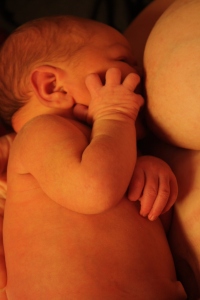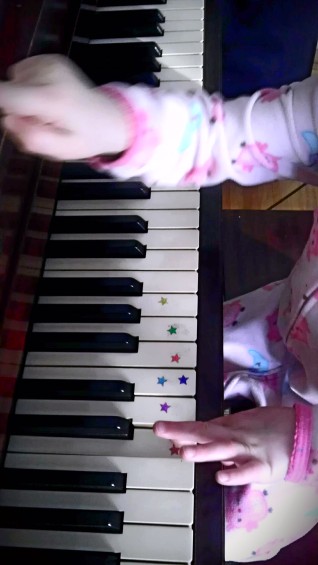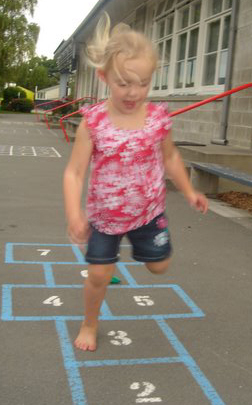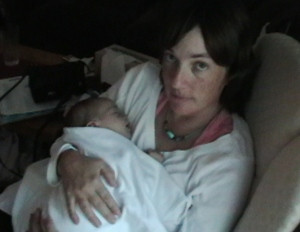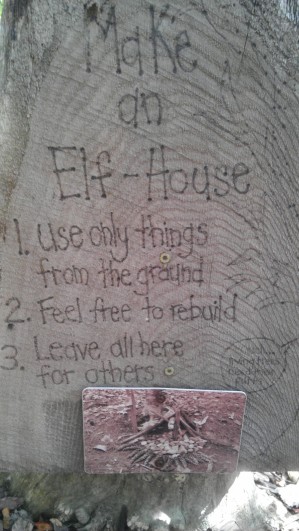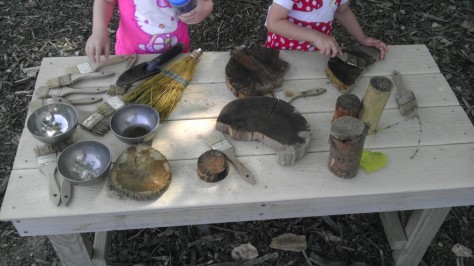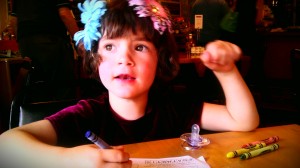It may sound trite to say there is no greater gift than something that expresses love and a piece of oneself, something beyond a store bought gift, but I have recently found that to be very true.
For my little girl’s third birthday I was inspired to do two things for her: One was to write a letter and one was to create a painting. Neither was originally meant to be a present; the ideas and the opportunity just happened to present themselves at the same time.
After I wrote the letter, I pulled up my blog and showed a friend of mine what I had written (“I Have Two Names Now: Mommy and Christina”). She paused thoughtfully and after a moment said, “You are leaving such a gift for her.”
My friend is a mother of two grown children and a grandchild that she also raised for the first three years of his life. This feedback coming from her meant something.
It was then that I knew I had written something meaningful; something that my daughter would carry with her through time.
My letter recaps the last few years as a mother and in particular how much my life has changed since I gave birth to my daughter. It also describes to her, while my memories are still fairly fresh, what her birth was like and what our relationship has been like these past three years.
I am thinking that perhaps I can print it out somehow and put it, with other such letters or essays, into a book that she can keep and cherish for a long time to come.
The comment that my friend made caused me think about the importance of gift giving and how ethereal the types of gifts we normally give are.
If one thinks back on it, the things we really hold onto the longest and the closet to our hearts are the photographs and memories of family and friends.
As one of her “real” presents, I gave her a very cute, Elmo playdough machine that talks in an Elmo voice and tells you whether you should make a square or a circle. It’s cute but in a few years it will most likely be long forgotten, as will the stickers or some of the other toys she was given. Many will end up in the donation box for other young children or will break after a few years of use.
These gifts will become distant memories, if memories at all.
But the letter will live on, even as she grows into an adult herself, or has children of her own.
The two paintings were inspired by Eric Carle’s illustrations in two of his books. The Very Hungry Caterpillar and Panda Bear, Panda Bear, What Do You See? From the The Very Hungry Caterpillar I chose the beautiful butterfly that the caterpillar turns into at the end of the story. Carle’s rendition of this butterfly is simply beautiful.
The second painting is of a crane in Panda Bear, Panda Bear, What Do You See? I chose the crane for my daughter’s Godfather to paint because there is something about that crane that draws my child in. Whenever we read the book she always insists on turning back to that page.
Because she likes the crane so much, I thought it would be lovely to have a painting of it hanging on the wall behind her bed. We could look at the painting and talk about it while we read the book.
The paintings did not take much effort – even for two novices to acrylics. I had bought some canvasses and I sketched the outline of the animals onto the canvas. I had learned this technique from a local art studio that offers one night classes to adults who would like to paint. To actually create the paintings we then went to the studio for another one night class. The studio provides everything one needs: brushes, paints, easels, gentle instruction. It was quite enjoyable.
(There is an art studio in town called Simply Jane where you can go for a one night class called Paint with a Pint. Off we went with our bottle of wine, bags of chips, cookies and unpainted canvases. I had attended a class there before called Paint the Greats and the Sharpie idea came from there.)
We spent the next three hours with our bottle of wine, chips, easels and acrylics painting our pictures. The teacher then sprayed them with a glossy spray to protect the paint.
Here are the final products of our work. I think they look wonderful and I am so happy that I have them to offer up as a special gift.
Eric Carle’s butterfly:
My butterfly:
Eric Carle’s Crane:
Randy’s Crane:
I love these painting and I am sure my daughter will come to love these paintings as much as I do. Both will be hanging in her bedroom over her bed and hopefully she will cherish them forever.
But at the same time, it has occurred to me that although these paintings are a gift to my daughter, they are also a gift to me. For a brief moment they stop the clock at the age of three and they will hold a special meaning for me that even she will never be able to understand.
No matter how old my daughter becomes, whenever I look at those paintings I will remember what she was like as a three year old and how meaningful those images were to her at that time in her life.
I will remember parenting my little three year old girl and I will remember how she looked at them and said “Butterfly!” and “Geese!” when she was asked what they were.
They started out as a gift for her but in turn have become something even greater, a wonderful reminder of the fleeting moments of childhood and the special times we enjoy.
In the future, I hope that I am equally inspired to create some special gift that will stay with her for a lifetime and that will carve out a special place in my heart for me to revisit as my baby grows up and becomes a young woman.
Minneapolis Resources:
Here is Simply Jane’s Facebook page if you would like to see more:




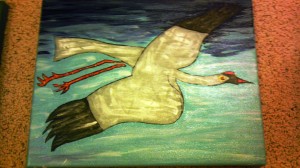
 What most people don’t realize is that pediatric occupational therapists are in a unique position to do something about a very real problem.
What most people don’t realize is that pediatric occupational therapists are in a unique position to do something about a very real problem. more meaningful, what if we allowed children to play in mud puddles during treatment sessions? Our mud puddles here at TimberNook headquarters are so huge that they also have real frogs and frog eggs in them. The kids have to maneuver through the mud, using their balance, visual scanning skills, and engaging their tactile (touch) senses as they search for a frog.
more meaningful, what if we allowed children to play in mud puddles during treatment sessions? Our mud puddles here at TimberNook headquarters are so huge that they also have real frogs and frog eggs in them. The kids have to maneuver through the mud, using their balance, visual scanning skills, and engaging their tactile (touch) senses as they search for a frog.






